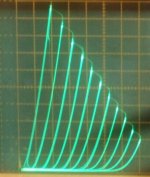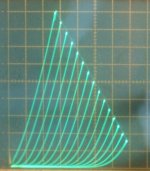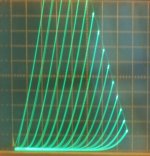807 triode curves here (datasheet from Frank's again):
https://frank.pocnet.net/sheets/049/8/807.pdf
https://frank.pocnet.net/sheets/049/8/807.pdf
Curves on those scales are almost never flattering (304TL certainly an exception) but I'd bet that your triode connected Howard Johnsons might hold up pretty darned well.
Much thanks, as always,
Chris
Much thanks, as always,
Chris
"Seems to me this forum, is becoming more and more about "why do it simple, when we can make it massively-stupidly overcomplicated". Every post I've read of yours 6vheater says the same thing, your all f***in idiots and I know better. Yawn.
Andy.
This, and it's ruining my reading experience
??triode connected Howard Johnsons
6HJ5 in triode? Not real special in triode, some curve roll-over.
Try 26LX6 or 26LW6 for super triodes. (not that they will work for long as triodes, suffer run-away at HV in direct triode mode over time)
The Sweeps need a screen V drop or an R divider with a Mosfet follower to get the screen V down some for psuedo-triode.
Might be interesting to parallel a pentode and a "shunt Schaded" pentode (or beam tetrodes...) to make the "extended" class A version.
OOPs:
"why do it simple, when we can make it massively-stupidly overcomplicated"
Well, just having fun I guess, why not.
(I'm working with a Panoramic Distortion Visualizer lately, so I can see immediately what all these strange variants actually do to the gain curve and cross-over. I'll be starting a thread on this in the early Spring. Having too much fun with it right now. No more stupid FFTs! And so easy to make!)
,
Last edited:
6HJ5 in triode? Not real special in triode, some curve roll-over.
Dunno, looked great to me. But I'm only interested in the lightly loaded juiciest bits. "Watts" is a much misunderstood figure of merit. Just me, of course.
And very much thanks for your efforts for the DIYaudio community. Might seem under-appreciated sometimes, but it's not.
Much the best to you and yours,
Chris
Thanks!
I would say 6HJ5 is typical in triode mode for Sweep tubes, certainly OK. (pic 1 below)
26/36LW6, 26LX6, 36MC6, 12HL7, 6LQ8, some 6JC6, and many others make some amazing triode curves. (pics 2 to 5: 36LW6, 6LQ8, 6197, 12HL7)
(often depends on the make, and then some selecting on the curve tracer)
https://www.diyaudio.com/forums/tub...ificent-television-tubes-106.html#post5520737
211 has nice triode curves, but way too HV and Hi Z.
I would say 6HJ5 is typical in triode mode for Sweep tubes, certainly OK. (pic 1 below)
26/36LW6, 26LX6, 36MC6, 12HL7, 6LQ8, some 6JC6, and many others make some amazing triode curves. (pics 2 to 5: 36LW6, 6LQ8, 6197, 12HL7)
(often depends on the make, and then some selecting on the curve tracer)
https://www.diyaudio.com/forums/tub...ificent-television-tubes-106.html#post5520737
211 has nice triode curves, but way too HV and Hi Z.
Attachments
Last edited:
Type 211 has been my favorite for a long time, probably not long after the _Sound Practices_ era. When Joe R published the type 845 curves, I became a devote, and built an amp to see what all the fuss was about. Short journey to the even better type 211 curves, and their mu=12 constraints.
My building partner (itishifi.com) and I are working on a platform to use a choice of type 304TL, 3x type 211 parallel, or type 450TL, with the same OPTs, HV supply, and (very robust) drivers. Output stage(s) on separate interchangable chassis with their dedicated filament supplies. HV supply is done, pix on his blog. I'm old, so it goes slow by his standards.
ps: did get a supply of the H-E-double-hockeysticks valves at your recommendation. They'll figure prominently in near-term projects.
Much thanks,
Chris
My building partner (itishifi.com) and I are working on a platform to use a choice of type 304TL, 3x type 211 parallel, or type 450TL, with the same OPTs, HV supply, and (very robust) drivers. Output stage(s) on separate interchangable chassis with their dedicated filament supplies. HV supply is done, pix on his blog. I'm old, so it goes slow by his standards.
ps: did get a supply of the H-E-double-hockeysticks valves at your recommendation. They'll figure prominently in near-term projects.
Much thanks,
Chris
Last edited:
Maybe I try some other 807 brands some time.
It was necessary to add HF coils (made of 1,5mm silver wire) to the 807 anode caps.
Otherwise some wild HF oscillations appeared at a specific output level, perhaps because of poor russian 807 specimen.
20Ohm resistors also worked.
No, that's just 807s being 807s. The type likes to make snivets. Install 1K5 screen stoppers and plate parasitic suppressors to prevent that.
- Home
- Amplifiers
- Tubes / Valves
- 807 Extended Class A Amplifier [1954 style]




